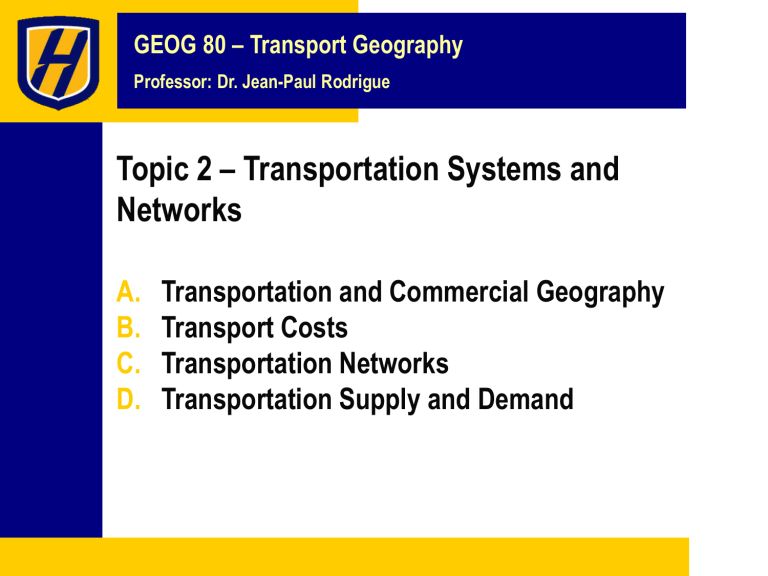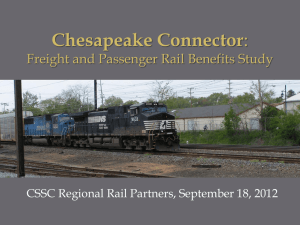Chapter 2 Transportation Systems and Networks

GEOG 80 – Transport Geography
Professor: Dr. Jean-Paul Rodrigue
Topic 2 – Transportation Systems and
Networks
A.
Transportation and Commercial Geography
B.
Transport Costs
C.
Transportation Networks
D.
Transportation Supply and Demand
C – Transportation Networks
■ 1. Transport Networks
■ 2. The Topology and Typology of Networks
■ 3. Networks and Space
1. Transport Networks
■ Transport network
• Framework of routes between locations:
• A permanent track (e.g. roads, rail and canals).
• A scheduled service (e.g. airline, transit, train).
• Various types of links between points along which movement can take place.
• Creates accessibility.
■ Network structure
• Ranges from centripetal to centrifugal.
• Express inequalities between places.
• Express transport rates.
• Integration processes impacted on the structure and flows of transportation networks.
Centrifugal and Centripetal Networks
Centrifugal Centripetal
Network Structures
Centralized Decentralized Distributed
Transport Hub
Point-to-Point Hub-and-Spoke
Hub
Cost, Revenue and Level of Network Coverage
A
5
3
7
4
10
Cost: 10
Revenue: 15
Benefit: 5
B
Cost: 12
Revenue: 18
Benefit: 6
C
Cost: 14
Revenue: 25
Benefit: 11
D
Cost: 19
Revenue: 29
Benefit: 10
Impacts of Integration Processes on Networks and Flows
Before Integration
International border
After Integration
2. The Topology and Typology of Networks
■ Topology
• The arrangement and connectivity of a network.
• Each network has a specific topology.
Topology of a Network
Unidirectional link
Bi-directional link
Link
Node
Entry and exit
Exit
Entry
Types of Network Topology
Mesh Hub-and-Spoke
Linear Tree
Network Strategies to Service a Set of Locations
A
D
B
E
C
F
2. The Topology and Typology of Networks
■ Mode of territorial occupation
• Clearly defined and delimited:
• Strictly reserved space for transport infrastructure.
• Ownership can also be clearly established.
• Major examples include road, canal and railway networks.
• Vaguely defined and delimited:
• Space may be shared with other modes.
• Not the object of any particular ownership, only rights of passage.
• Examples include air and maritime transportation networks.
• Without definition:
• Space has no tangible meaning, except for the distance it imposes.
• Little control and ownership are possible.
• Agreements must be reached for common usage.
• Examples are radio, television and cellular networks.
Mode of Territorial Occupation by Transport Networks
Overlap
Road
Rail Air corridor
Clearly defined Vaguely defined
Cellular coverage
Without definition
3. Networks and Space
■ Transportation networks and space
• Territorial organization of economic activities.
• Efforts incurred to overcome distance.
• Measured in absolute or relative terms
• Related to continuity, topographic space and spatial control.
• The territory is a topological space having two or three dimensions, depending on the transport mode considered.
• Flows and infrastructures are linear; having one dimension.
Transport Networks and Space
Transport Network
Space
Accessibility
Absolute and Relative Distance in a Network
10 km 30 minutes
3. Networks and Space
■ Spatial continuity
• Ubiquity:
• The possibility to reach any location from any other location.
• Fractionalization:
• The possibility for a traveler or an unit of freight to be transported without depending on a group.
• Instantaneous:
• The possibility to undertake transportation at the desired moment.
■ Topographic space
• Not a continuous space.
• Variety of physical features.
• Level of influence on the structure of transport networks:
• Depends on the mode.
Networks and Spatial Continuity
A B
C
3. Networks and Space
■ Tool for spatial control
• Roman and Chinese empires relied on transportation networks to control their respective territories.
• During the colonial era, maritime networks became a significant tool of trade, exploitation and political control.
• In the 19th century, transportation networks also became a tool of nation building and political control.
• In the 20th century, road and highways systems were built to reinforce this purpose.
• For the early 21st century, telecommunication networks have become means of spatial cohesion and interactions.
D – Transportation Supply and Demand
■ 1. Context
■ 2. Supply and Demand Functions
■ 3. Supply / Demand Relationships
1. Context
■ Transport supply
• The capacity of infrastructures and transport modes.
• Over a geographically defined transport system and for a specific period of time.
• Expressed in terms of infrastructures, services and networks.
• Quantification:
• Per unit of time and space.
• Number of passengers.
• Volume (for liquids or containerized traffic).
• Mass (for freight).
1. Context
■ Transport demand
• Expression of the transport needs of a territory:
• Generated by the economy.
• Composed persons, institutions and industries.
• Generates movements of people and freight
• Those needs can be satisfied, fully, partially or not at all.
• Quantification:
• Number of people, volume, or tons per unit of time and space.
■ Ton-km and Passenger-km
• Measures expressing the realized transport demand.
• Compares a transported quantity with a distance.
Ton-Miles of Freight Transported within the United
States, 1975-2000 (millions)
4,000,000
3,500,000
3,000,000
2,500,000
2,000,000
1,500,000
1,000,000
500,000
0
1975 1980 1985 1990 1995 2000
Air
Water
Pilelines
Truck
Rail
Passenger-Miles Transported within the United States,
1975-2000 (millions)
3,500,000
3,000,000
2,500,000
2,000,000
1,500,000
1,000,000
500,000
0
1975 1980 1985 1990 1995 2000
Rail
Urban Transit
Bus
Car
Air
Share of Total Domestic Freight Activity by Mode, G7
Countries, 1996
100
90
80
70
60
50
40
30
20
10
0
Canada France Germany Italy Japan United
Kingdom
United
States
Road
Rail
Oil Pipeline
Water
Air
Growth Factors in Transport Demand
Passengers
Freight
Growth in production and consumption
Income growth
Industrial relocation
Economic specialization
Suburbanization
KM
Average Distance
2. Supply and Demand Functions
■ Transport supply
• Functions representing what are the main variables influencing the capacity of transport systems.
• Variables are different for each mode.
• Road, rail and telecommunications:
• Dependent on the capacity of the routes and the vehicles.
• Air and maritime transportation:
• Influenced by the capacity of the terminals.
• Transport of people and freight:
• Expressed in number of vehicles, people or tons over a time period.
• The supply of one mode influences the supply of others.
• Dependent of the capacity of intermodal infrastructures.
Major Supply Variables for Transportation Modes
Road
•Lanes
•Width
•Speed limit
•Parking
Rail
•Tracks
•Grade
Air
•Corridors
•Yards
•Transshipment
•Runways
•Dockways
Maritime
•Canals
•Locks
•Docks
•Transshipment
•Speed
•Passengers
•Tonnage
•Speed
•Passengers
•Tonnage
•Speed
•Passengers
•Tonnage
•Speed
•Tonnage
Atmospheric Conditions
2. Supply and Demand Functions
■ Transport demand
• Related to economic and social activity patterns.
• Stable and recurrent; allows the planning of services.
• Unstable and uncertain; difficult to offer an adequate level of service.
• Passengers:
• Function of demographic attributes of the population such as income, age, standard of living, race and sex, as well as modal preferences.
• Freight:
• Function of economic activities (GDP, commercial surface, number of tons of ore extracted, etc.) and of modal preferences.
• Information:
• Population (telephone calls) and the volume of financial activities (stock exchange).
• Standard of living and education levels.
3. Supply / Demand Relationships
■ Transport supply and demand interactions
• Supply curve:
• Quantity of transport services offered according to price.
• The higher the price, the more suppliers are willing to offer a transport service.
• Demand curve:
• Quantity of transport services consumed according to price.
• The higher the price, the less users are willing to consume that service.
• Equilibrium price:
• Supply and demand interact until an equilibrium is reached.
• Quantity of transportation the market is willing to use at a given price.
• Quantity being supplied.
Classic Transport Demand / Supply Function
Cost
Demand
D
Elasticity
T 2
T 1
C 2
C 1
Supply
S1
S2
Equilibrium
C1
C2
T1 T2
Traffic
2. Supply and Demand Functions
■ Considerations
• Entry costs:
• High in some sectors (maritime, rail and air). Oligopolisitc.
• Low in other (trucking).
• Public sector:
• High level of public involvement.
• Provision of transport infrastructures.
• Transport costs are partially subsidized.
• Government control (and direct ownership).
• Elasticity.
• Variation of demand in response to a variation of cost.
• Transport demand has a tendency to be inelastic.
• Commuting: inelastic in terms of costs but elastic in terms of time.
• Freight: inelastic.
• Air transportation: elastic (tourism).
Transport Elasticity by Activity
100%
Traffic
0%
Emergency
Commuting
Major Purchase
Special Event
Social Activities
Cost
Recreation
Transport Supply, Demand and Travel Time
Morning peak
Afternoon peak
Transport supply (A)
Transport Demand (T)
T>A
T<A
Time of the Day



